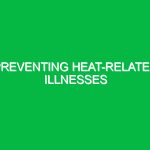As the winter months approach, the importance of understanding cold stress and frostbite prevention becomes increasingly critical, particularly in the Health, Safety, and Environment (HSE) context. Cold stress refers to health risks posed by cold environments, which can lead to serious conditions such as hypothermia and frostbite. In workplaces where employees are exposed to harsh weather conditions—such as construction sites, oil rigs, or outdoor maintenance—the implications of cold stress can be profound. This article will delve into the risks associated with cold stress and frostbite and provide actionable strategies for prevention, ensuring a safer working environment for all.
The Importance of Cold Stress and Frostbite Prevention
Cold stress can manifest in various forms, affecting physical and mental health. The risk increases dramatically in environments where individuals are exposed to low temperatures, wind, and moisture. Frostbite, a specific form of cold stress, occurs when skin and underlying tissues freeze. Understanding how to prevent these conditions isn’t just about adhering to regulations; it’s about protecting lives.
In my time working at a facility that operated outdoors during winter, I witnessed the real dangers posed by cold stress firsthand. A colleague, who was rushed to the hospital with frostbite on his fingers, spent weeks recovering. His experience underscored the need for comprehensive training and awareness around cold stress prevention. Such incidents can be mitigated with the right knowledge and protocols in place.
Identifying Hazards and Risks Associated with Cold Stress
Understanding the hazards associated with cold stress is the first step in prevention. Several factors contribute to cold stress, and identifying them can help mitigate risks. Here are some of the key hazards:
1. Low Temperatures
Prolonged exposure to cold temperatures can lead to a drop in body temperature and increase the risk of hypothermia. Even temperatures above freezing can be hazardous when combined with wind, which can strip body heat quickly.
2. Wind Chill
Wind chill is a critical factor in cold stress. Wind can make it feel significantly colder than the actual temperature. A temperature of 30°F can feel like 20°F with a wind speed of 10 mph, increasing the risk of frostbite.
3. Wet Conditions
Moisture from rain, snow, or sweat can lead to rapid heat loss. Wet clothing loses its insulating properties, making it vital to wear appropriate gear that keeps moisture away from the body.
4. Inadequate Clothing
Not all clothing is suitable for cold weather. Workers often underestimate the necessity of thermal layers, moisture-wicking materials, and windproof outer layers, leading to increased vulnerability to cold stress.
5. Fatigue and Poor Nutrition
Fatigue can impair judgment and slow reaction times. Additionally, not consuming enough calories can lead to decreased body heat production, increasing the risk of cold stress. Workers must maintain energy levels through proper nutrition, especially in cold conditions.
Best Practices for Cold Stress and Frostbite Prevention
Preventing cold stress and frostbite requires a multifaceted approach, encompassing education, appropriate clothing, and proactive measures. Here are some actionable best practices:
1. Training and Awareness
Regular training sessions for employees on the signs and symptoms of cold stress are essential. Understanding how to recognize early symptoms—like shivering, confusion, and numbness—can prompt timely intervention. Employees should also learn the importance of regular breaks to warm up.
2. Appropriate Clothing
Encourage workers to wear layered clothing. The base layer should wick moisture away from the skin, the middle layer should provide insulation, and the outer layer must protect against wind and moisture. Gloves, hats, and thermal socks are critical for protecting extremities.
3. Hydration and Nutrition
Maintaining hydration is crucial, even in cold weather. Encourage workers to drink warm fluids and consume high-energy foods. Hot meals can provide thermal comfort and energy, which are vital for maintaining body heat.
4. Work Scheduling
Limit exposure time to extreme conditions by scheduling outdoor work during the warmest parts of the day. Implement a buddy system where workers can monitor each other for signs of cold stress, fostering a culture of safety.
5. Use of Technology
Employ technology such as temperature sensors and wearable devices to monitor workers’ exposure to cold. Alerts can be set for when conditions become dangerous, prompting necessary action.
6. Immediate Response Procedures
Have clear, actionable procedures in place for responding to cold stress incidents. This includes knowing how to warm an affected individual safely and when to seek medical help. Providing first-aid training tailored to cold-related injuries is beneficial.
Regulations and Standards Governing Cold Stress Prevention
Several regulations and standards govern the management of cold stress in the workplace. Understanding these can help organizations remain compliant while also protecting their workforce:
1. OSHA Standards
The Occupational Safety and Health Administration (OSHA) does not have a specific standard for cold stress but requires employers to provide a safe work environment. Employers must be proactive in assessing hazards and implementing strategies to mitigate risks.
2. ANSI/ISEA 105
The American National Standards Institute (ANSI) provides guidelines on protective clothing and equipment for cold weather. Adhering to these standards ensures that workers have access to the right gear for their tasks.
3. NIOSH Guidelines
The National Institute for Occupational Safety and Health (NIOSH) offers resources and guidelines for preventing cold stress. These guidelines provide a framework for assessing workplace conditions and developing effective prevention strategies.
Conclusion
Cold stress and frostbite prevention are critical components of workplace safety, particularly in environments exposed to harsh winter conditions. Understanding the risks associated with cold exposure, implementing best practices, and adhering to regulations can protect workers’ health and well-being. By fostering a culture of safety that prioritizes cold stress prevention, organizations can ensure that their workforce remains safe, productive, and healthy, even in the coldest months. As we move forward, let us all embrace the knowledge and tools at our disposal to create safer working environments for everyone.


